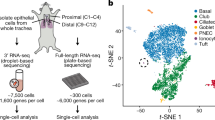Abstract
The CRISPR-Cas9 technology is a powerful tool that enables site-specific genome modification (gene editing) and is increasingly used in research to generate gene knockout or knock-in in a variety of cells and organisms. This chapter provides a brief overview of this technology and describes a general methodology applicable to human airway biology research.
Access this chapter
Tax calculation will be finalised at checkout
Purchases are for personal use only
Similar content being viewed by others
References
Barrangou R, Fremaux C, Deveau H, Richards M, Boyaval P, Moineau S et al (2007) CRISPR provides acquired resistance against viruses in prokaryotes. Science 315:1709–1712
Brouns SJ, Jore MM, Lundgren M, Westra ER, Slijkhuis RJ, Snijders AP et al (2008) Small CRISPR RNAs guide antiviral defense in prokaryotes. Science 32:960–964
Marraffini LA, Sontheimer EJ (2008) CRISPR interference limits horizontal gene transfer in staphylococci by targeting DNA. Science 322:1843–1845
Ishino Y, Shinagawa H, Makino K, Amemura M, Nakata A (1987) Nucleotide sequence of the iap gene, responsible for alkaline phosphatase isozyme conversion in Escherichia coli, and identification of the gene product. J Bacteriol 169:5429–5433
Mojica FJ, Díez-Villaseñor C, Soria E, Juez G (2000) Biological significance of a family of regularly spaced repeats in the genomes of Archaea, Bacteria and mitochondria. Mol Microbiol 36:244–246
Bolotin A, Quinquis B, Sorokin A, Ehrlich SD (2005) Clustered regularly interspaced short palindrome repeats (CRISPRs) have spacers of extrachromosomal origin. Microbiology 151:2551–2561
Pourcel C, Salvignol G, Vergnaud G (2005) CRISPR elements in Yersinia pestis acquire new repeats by preferential uptake of bacteriophage DNA, and provide additional tools for evolutionary studies. Microbiology 151:653–663
Marraffini LA (2015) CRISPR-Cas immunity in prokaryotes. Nature 526:55–61
Mali P, Yang L, Esvelt KM, Aach J, Guell M, DiCarlo JE et al (2013) RNA-guided human genome engineering via Cas9. Science 339:823–826
Ran FA, Hsu PD, Wright J, Agarwala V, Scott DA, Zhang F (2013) Genome engineering using the CRISPR-Cas9 system. Nat Protoc 8:2281–2308
Mojica FJ, Díez-Villaseñor C, García-Martínez J, Almendros C (2009) Short motif sequences determine the targets of the prokaryotic CRISPR defense system. Microbiology 155:733–740
Bauer DE, Canver MC, Orkin SH (2015) Generation of genomic deletions in mammalian cell lines via CRISPR/Cas9. J Vis Exp 95:e52118
Acknowledgments
This work was supported by the following grants from NIH: 1U19AI125357, R01HL122321, R01AI106287, and R01HL125128.
The authors wish to thank Max Seibold, Jamie Everman, and Ari Stoner (Dr. Max Seibold’s Lab, National Jewish Health, Denver) for technical advice and support.
Author information
Authors and Affiliations
Corresponding author
Editor information
Editors and Affiliations
Rights and permissions
Copyright information
© 2018 Springer Science+Business Media, LLC, part of Springer Nature
About this protocol
Cite this protocol
Dakhama, A., Chu, H.W. (2018). The Use of CRISPR-Cas9 Technology to Reveal Important Aspects of Human Airway Biology. In: Reinhardt, R. (eds) Type 2 Immunity. Methods in Molecular Biology, vol 1799. Humana, New York, NY. https://doi.org/10.1007/978-1-4939-7896-0_27
Download citation
DOI: https://doi.org/10.1007/978-1-4939-7896-0_27
Published:
Publisher Name: Humana, New York, NY
Print ISBN: 978-1-4939-7895-3
Online ISBN: 978-1-4939-7896-0
eBook Packages: Springer Protocols




